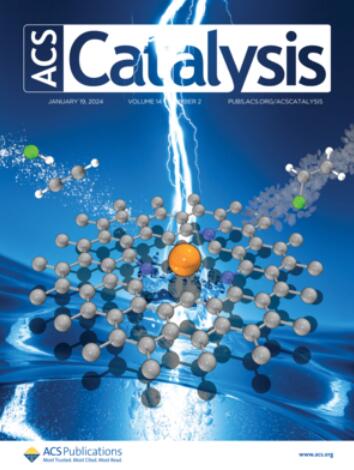Zr-Doped TiO2–x Nano-Oxide with Coordinatively Unsaturated Ti(Zr)–O Acid–Base Pairs for Efficient Propane Dehydrogenation
IF 11.3
1区 化学
Q1 CHEMISTRY, PHYSICAL
引用次数: 0
Abstract
Recently, some traditional oxide supports, such as nano TiO2 and ZrO2 with high surface energy, have been found to be partially reduced to generate oxygen vacancies and coordinatively unsaturated metal (Mcu) cations as efficient active sites for nonoxidative propane dehydrogenation (PDH). However, the primary challenge in their industrial applications is rapid deactivation because of coke, over-reduction, and aggregation under the reaction conditions of high temperature and reducible atmosphere. Herein, we reported that cost-effective and environmentally friendly Zr-doped TiO2 (TixZr1) prepared by a simple coprecipitation method can be used as a highly efficient and stable catalyst for PDH. Ti3Zr1 exhibited the C3H6 formation rate [r(C3H6)] of 0.6 mmol g–1 min–1 at 550 °C, which was 17 times that of pure TiO2, and a deactivation constant (Kd) 2.8 times lower than that of commercial TiO2. Moderate Zr doping promotes the generation of surface active lattice oxygen, which can be reduced at a relatively low temperature to form oxygen vacancies and Ti(Zr)cu–O acid–base pairs as the active sites for PDH, and their number is in line with r(C3H6) of TixZr1 catalysts. With the increase of the Zr doping amount, the bulk crystal phase of TixZr gradually transforms from Zr-doped anatase TiO2 to TiZrO4 via Ti2ZrO6 with enhanced thermostability, which can inhibit over-reduction and aggregation of the nano-oxide.

求助全文
约1分钟内获得全文
求助全文
来源期刊

ACS Catalysis
CHEMISTRY, PHYSICAL-
CiteScore
20.80
自引率
6.20%
发文量
1253
审稿时长
1.5 months
期刊介绍:
ACS Catalysis is an esteemed journal that publishes original research in the fields of heterogeneous catalysis, molecular catalysis, and biocatalysis. It offers broad coverage across diverse areas such as life sciences, organometallics and synthesis, photochemistry and electrochemistry, drug discovery and synthesis, materials science, environmental protection, polymer discovery and synthesis, and energy and fuels.
The scope of the journal is to showcase innovative work in various aspects of catalysis. This includes new reactions and novel synthetic approaches utilizing known catalysts, the discovery or modification of new catalysts, elucidation of catalytic mechanisms through cutting-edge investigations, practical enhancements of existing processes, as well as conceptual advances in the field. Contributions to ACS Catalysis can encompass both experimental and theoretical research focused on catalytic molecules, macromolecules, and materials that exhibit catalytic turnover.
 求助内容:
求助内容: 应助结果提醒方式:
应助结果提醒方式:


